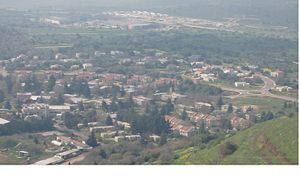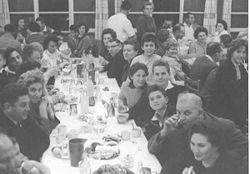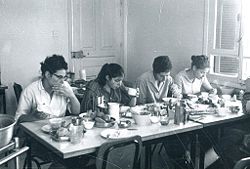A Kibbutz (Hebrew: ◊ß◊ô◊Ď◊ē◊•), plural Kibbutzim (Hebrew: ◊ß◊ô◊Ď◊ē◊¶◊ô◊Ě), from the Hebrew word meaning "gathering" or "together," is an Israeli collective community. The Kibbutzim movement combines socialism and Zionism in a form of practical Labor Zionism, founded at a time when independent farming was not practical. Forced by necessity into communal life, and inspired by their own socialist ideology, kibbutz members developed a pure communal mode of living that attracted interest from the entire world. Of particular interest was their collective mode of child-rearing, in which the children, like all their property, were considered as under collective ownership and responsibility. The Children's Societies provided a place and adults who raised all the children together, meeting their parents only at scheduled visits.
While the kibbutzim lasted for several generations as utopian communities, most of today's kibbutzim are scarcely different from the capitalist enterprises and regular towns to which they were originally supposed to be alternatives. Today, farming has been partially abandoned in many cases, with technology industries commonly replacing them. Nuclear families have replaced the Children's Societies.
Though the kibbutz movement never accounted for more than seven percent of the Israeli population, it did more to shape the image Israelis have of their country, and the image that foreigners have of Israel, than any other Israeli institution.
Ideology of the Kibbutz movement
The spiritualism of the pioneers of the kibbutz movement consisted of mystical feelings about Jewish work, articulated by labor Zionists like Berl Katznelson, who said, "everywhere the Jewish laborer goes, the divine presence goes with him."[1]
In addition to redeeming the Jewish nation through work, there was also an element of redeeming Eretz Yisrael, or Palestine, in the kibbutz ideology.
Kibbutz members took pleasure in bringing the land back to life by planting trees, draining swamps, and countless other activities to make the land more fertile. In soliciting donations, kibbutzim and other Zionist settlement activities presented themselves as "making the desert bloom."
The first kibbutzniks hoped to be more than plain farmers in Palestine. They wanted to create a new type of society where there would be no exploitation of anyone and where all would be equal. The early kibbutzniks wanted to be both free from working for others and free from the guilt of exploiting hired work. Thus was born the idea that Jews would band together, holding their property in common, "from each according to his ability, to each according to his needs."
Kibbutz members were not orthodox Marxists. Marxists did not believe in nations, whereas those kibbutzniks who leaned toward nationalistic Zionism did. Traditional Marxists were hostile to Zionism, even its communist manifestations. Although kibbutzniks practiced communism themselves, they did not believe that communism would work for everyone. Kibbutz political parties never called for the abolition of private property; Kibbutzniks saw kibbutzim as collective enterprises within a free market system.
History
Origins
In the late nineteenth and early twentieth centuries, conditions were especially hard for the Jews of the Russian Empire. It was the underlying policy of the Russian government in its May Laws to "cause one-third of the Jews to emigrate, one-third to accept baptism, and one-third to starve."[2] Except for a wealthy few, Jews could not leave the Pale of Settlement; within it, Jews could neither live in large cities, such as Kiev, nor any village with fewer than 500 residents, even if a person needed rural medical recuperation. In case any Jews made their way into Moscow, in 1897, the Moscow Chief of Police offered a bounty for the capture of an illegal Jew equal to the capture of two burglars.[3]
Jews responded to the pressures on them in different ways. Some saw their future in a reformed Russia and joined Socialist political parties. Others saw the future of Jews in Russia as being out of Russia, and thus emigrated to the West. Last, but not least, among the ideological choices that presented themselves to Jews in late nineteenth century Russia was Zionism, the movement for the creation of a Jewish homeland in the cradle of Judaism, Palestine, or, as Jews called it, Eretz Yisrael.
In the 1880s, approximately 15,000 Jews, mostly from southern Russia, moved to Palestine with the dual intentions of living there and farming there. This movement of Jews to Palestine in the 1880s is called the "First Aliyah."
The First Kibbutzim
The Jews of the First Aliyah generation believed that Diaspora Jews had sunk low due to their typical disdain for physical labor. Their ideology was that the Jewish people could be "redeemed physically as well as spiritually by toiling in the fields of Palestine.‚ÄĚ
The Biluim came to Eretz Yisrael with high hopes of success as a peasant class, but their enthusiasm was perhaps greater than their agricultural ability. Within a year of living in Palestine, the Biluim had become dependent on charity, just as their scholarly brethren in Jerusalem were. Thanks to donations from extremely wealthy Jews, such as Baron Edmond James de Rothschild, the Biluim were able to eventually prosper. Their towns, Rishon LeZion, Rehovot, and Gedera developed into dynamic communities while their culture of labor evolved: Instead of cultivating the soil on their own land, the Biluim hired Arabs to work the land in their place.
Tensions flared up once again in Russia in the first years of the twentieth century, which inspired another wave of Russian Jews to emigrate. As in the 1880s, most emigrants went to the United States, but a minority went to Palestine. It was this generation that would include the founders of the kibbutzim.
Most members of the Second Aliyah wanted to farm the land, but becoming independent farmers was not a realistic option. In 1909, Joseph Baratz, nine other men, and two women established themselves at the southern end of the Sea of Galilee near an Arab village called "Umm Juni." These teenagers had hitherto worked as day laborers draining swamps, as masons, or as hands at the older Jewish settlements. Their dream was now to work for themselves, building up the land.
Ottoman Palestine was a harsh environment, quite unlike the Russian plains the Jewish immigrants were familiar with. The Galilee was swampy, the Judean Hills rocky, and the South of the country, the Negev, was a desert. Living collectively was simply the most logical way to be secure in an unwelcoming land. On top of considerations of safety, there were also those of economic survival. Establishing a new farm in the area was a capital-intensive project; collectively the founders of the kibbutzim had the resources to establish something lasting, while independently they did not.
They called their community "Kvutzat Degania," after the cereals where they grew up. Their community would grow into the first kibbutz. Baratz wrote about his experiences:
We were happy enough working on the land, but we knew more and more certainly that the ways of the old settlements were not for us. This was not the way we hoped to settle the country‚ÄĒthis old way with Jews on top and Arabs working for them; anyway, we thought that there shouldn't be employers and employed at all. There must be a better way.[4]
Development
Despite facing significant difficulties, kibbutzim grew and proliferated. By 1914, Degania had fifty members. Other kibbutzim were founded around the Sea of Galilee and the nearby Jezreel Valley. The founders of Degania themselves soon left Degania to become apostles of agriculture and socialism for newer kibbutzim.
Kibbutzim and the whole Jewish community in Palestine grew as a result of the increase in Anti-Semitism in Europe. In contrast to the prediction anti-Zionist Jews had made prior to World War I, the spread of liberal ideas was not irreversible and the position of Jews in many Central and Eastern European societies actually deteriorated. To escape the pogroms, tens of thousands of Russian Jews immigrated to Palestine in the early 1920s, in a wave of immigration that was called the "Third Aliyah." In contrast to those who came as part of the Second Aliyah, these youth group members had some agricultural training before embarking and had already held meetings and made preparations to begin kibbutz life.
Kibbutzim founded in the 1920s, tended to be larger than the kibbutzim founded prior to World War I. Degania had only twelve members at its founding. Ein Harod, founded only a decade later, began with 215 members. Altogether, kibbutzim grew and flourished in the 1920s. In 1922, there were scarcely 700 individuals living on kibbutzim in Palestine. By 1927, the kibbutz population was approaching 4,000. By the eve of World War II, the kibbutz population was 25,000, 5 percent of the total population of the whole Yishuv settlement.
Challenges
The establishment of Israel and the flood of Jewish refugees from Europe and the Muslim world presented challenges and opportunities for kibbutzim. The immigrant tide offered kibbutzim a chance to expand through new members and inexpensive labor, but it also meant that Ashkenazi kibbutzim would have to adapt to Jews whose background was far different from their own.
Many of the kibbutzim were secular, even staunchly atheistic, although they wanted their new communities to have Jewish characteristics nonetheless. Friday nights were still "Shabbat" with a white tablecloth and fine food, and work was not done on Saturday if it could be avoided. Kibbutzniks marked holidays like Shavuot, Sukkot, and Passover with dances, meals, and celebrations.
A major challenge that kibbutzim faced was the question of how to accommodate the hundreds of thousands of Middle Eastern Jews, or mizrahi. Many kibbutzim found themselves hiring Mizrahim to work their fields and expand infrastructure, but not actually admitting very many as members. Since few Mizrahim would ever join kibbutzim, the percentage of Israelis living on kibbutzim peaked around the time of statehood.
Kibbutzniks enjoyed a steady and gradual improvement in their standard of living in the first few decades after independence. In the 1960s, kibbutzim actually saw their standard of living improve faster than Israel's general population. The prestige that kibbutzniks enjoyed in Israel in the 1960s was reflected in the Knesset. When only four percent of Israelis were kibbutzniks, kibbutzniks made up 15 percent of Israel's parliament.[5]
Life in the Kibbutzim
Until the 1970s, the principle of equality was taken extremely seriously by all kibbutzim. Kibbutzniks did not individually own animals, tools, or even clothing. All gifts and income received from outside were turned over to the common treasury.
Social lives
Social lives were held in common as well. At some kibbutzim husbands and wives were discouraged from sitting together at communal meals, as marriage was a kind of exclusivity.
Although major decisions about the future of the kibbutz were made by consensus or by voting, day-to-day decisions about where people would work were made by elected leaders. Typically, kibbutzniks would learn their assignments by reading an assignment sheet.
Kibbutzim attempted to rotate people into different jobs. One week a person might work in planting, the next with livestock, the week after in the kibbutz factory and the following week in the laundry. Even managers would have to work in menial jobs. Through rotation, people took part in every kind of work, but it interfered with any process of specialization.
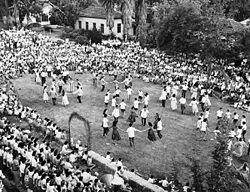
From the beginning, Kibbutzim had a reputation as culture-friendly and nurturing of the arts. Many kibbutzniks were and are writers, actors, or artists. In 1953, Givat Brenner staged the play My Glorious Brothers, about the Maccabee revolt, building a real village on a hilltop as a set, planting real trees, and performing for 40,000 people. Like all kibbutz work products at the time, all the actors were members of the kibbutz, and all were ordered to perform as part of their work assignments.
Children
The arrival of children at a new kibbutz posed certain problems. If kibbutzniks owned everything in common, then who was in charge of the children? This question was answered by regarding the children as belonging to all, even to the point of kibbutz mothers breastfeeding babies which were not their own.
In the 1920s kibbutzim began a practice of raising children communally away from their parents in special communities called "Children's Societies," or Mossad Hinuchi. The theory was that trained nurses and teachers would be better care-providers than so-called amateur parents. Children and parents would have better relationships due to the Children's Societies, since parents would not have to be disciplinarians, and there would exist no Oedipus complex. Also, it was hoped that raising children away from parents would liberate mothers from their "biological tragedy." Instead of spending hours a day raising children, women could thus be free to work or enjoy leisure.
In the heyday of Children's Societies, parents would only spend two hours a day, typically in the afternoon, with their children. As children got older, parents would sometimes go for days on end without seeing their offspring, except from chance encounters on the grounds of the kibbutz. Kibbutzim Children's Societies were one of the features of kibbutz life that most interested outsiders.
Some children who went through Children's Societies said they loved the experience, others remain ambivalent, while still others maintain that growing up without one's parents was very difficult. Years later, a kibbutz member described her childhood in a Children's Society:
"Allowed to suckle every four hours, left to cry and develop our lungs, we grew up without the basic security needed for survival. Sitting on the potty at regular intervals next to other children doing the same, we were educated to be the same; but we were, for all that, different ... At night the grownups leave and turn off all the lights. You know you will wet the bed because it is too frightening to go to the lavatory."[6]
Gender roles
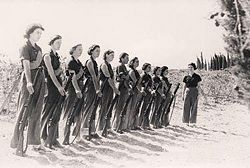
In the early days of the kibbutz movement the Kibbutzim tended to be male-dominated. The original female members had to perform many of the same tasks given to the male members, such as working in the fields. In many cases the women were still expected to perform traditional female roles, such as cooking, sewing, and cleaning in addition.
Eventually women in all the kibbutzim were allowed and even expected to do the same work as men, including armed guard duty. The desire to liberate women from traditional maternal duties was another ideological underpinning of the Children's Society system. Interestingly, women born on kibbutzim were much less reluctant to perform traditional female roles. It was the generation of women born on kibbutzim that eventually ended the Societies of Children. Also, although there was a "masculinization of women," there was no corresponding "feminization" of men. Women may have worked the fields, but men did not work in childcare.
Psychological aspects
In the era of independent Israel kibbutzim attracted interest from sociologists and psychologists who attempted to answer the question: What are the effects of life without private property? Or, what are the effects of life being brought up apart from one's parents?
Two researchers who wrote about psychological life on kibbutzim were Melford E. Spiro (1958) and Bruno Bettelheim (1969). Both concluded that a kibbutz upbringing led to individuals' having greater difficulty in making strong emotional commitments thereafter, such as falling in love or forming a lasting friendship. On the other hand, they appeared to find it easier to have a large number of less-involved friendships, and a more active social life.
Other researchers came to the conclusion that children growing up in these tightly knit communities tended to see the other children around them as ersatz siblings and preferred to seek mates outside the community when they reached maturity. Some theorized that living amongst one another on a daily basis virtually from birth on produced an extreme version of the Westermarck effect, which subconsciously diminished teenage kibbutzniks' sexual attraction to one another. Partly as a result of not finding a mate from within the kibbutz, youth often abandoned kibbutz life as adults.
Economics
Even prior to the establishment of the state of Israel, kibbutzim had begun to branch out from agriculture into manufacturing. Kibbutz Degania, for instance, set up a factory to fabricate diamond cutting tools; it now grosses several million dollars a year. Kibbutz Hatzerim has a factory for drip irrigation equipment. Hatzerim's business, called Netafim, is a multinational corporation that grosses over $300 million a year. Maagan Michael branched out from making bullets to making plastics and medical tools. Maagan Michael's enterprises earn over $100 million a year. A great wave of kibbutz industrialization came in the 1960s, and today only 15 percent of kibbutz members work in agriculture.
Future
Kibbutzim have gradually and steadily become less collectivist. Rather than the principle of "From each according to his ability, to each according to his needs," kibbutzim have adopted "from each according to his preferences, to each according to his needs."
The first changes to be made were in utilities and in the dining hall. When electricity was free, kibbutzniks had no incentive to save energy. In the 1980s, kibbutzim began to meter energy usage. Having kibbutzniks pay for energy usage required kibbutzniks to have personal money.
Eating arrangements also had to change. When food was free, people had no incentive to take the appropriate amount. Every kibbutz dining hall would end the night with enormous amounts of extra food; often this food would be fed to the animals. Now 75 percent of kibbutz dining halls are pay as you go a la carte cafeterias.
Though Kibbutzniks see their neighbors more than other Israelis, they have begun to live private lives. Most kibbutz dining halls are no longer even open for three meals a day. Group activities are much less well attended than they were in the past and are now infrequently scheduled.
In the 1970s, nearly all kibbutzim abandoned Children's Societies in favor of the traditional nuclear family. The reasons were many. Some kibbutzim believed that communal life for children led to psychological problems; some said that giving up one's children was too great a sacrifice for parents.
Kibbutzniks no longer expect to transform the rest of Israel, or the globe, into one large collectivist project, but they have not given up on changing the world in smaller ways. Kibbutzniks are prominent in Israel's environmental movement. Some kibbutzim try to generate all their power through solar cells. Kibbutzniks are also prominent among Israel's peace activists.
Legacy
Although there may be hundreds of entities in Israel calling themselves kibbutzim, the collectivist impulse is gone. Some kibbutzim have been criticized for "abandoning" socialist principles and turning to capitalist projects in order to make the kibbutz more self-sufficient economically. Numerous kibbutzim have moved away from farming and instead developed parts of their property for commercial and industrial purposes, building shopping malls and factories on kibbutz land that serve and employ non-kibbutz members while the kibbutz retains a profit from land rentals or sales. Conversely, kibbutzim which have not engaged in this sort of development have also been criticized for becoming dependent on state subsidies to survive.
Nonetheless, kibbutzniks played a role in Yishuv society and then Israeli society, far out of proportion to their population. From Moshe Dayan to Ehud Barak, kibbutzniks have served Israel in positions of leadership. Kibbutzim also contributed greatly to the growing Hebrew culture movement. Likewise, kibbutzim have disproportionately affected the views that the rest of the world has of Israel and the image Israelis have of their country.
Notes
- ‚ÜĎ Tom Segev, One Palestine, Complete: Jews and Arabs under the British Mandate (Picador, 2001).
- ‚ÜĎ Elliot Rosenberg, But Were They Good for the Jews? (Citadel, 2000).
- ‚ÜĎ S.M. Dubnow, History of the Jews in Russia and Poland (Philadelphia: Jewish Publication Society of America, 1920).
- ‚ÜĎ Joseph Baratz, A Village by the Jordan: The Story of Degania (Tel Aviv: Ichud Habonim, 1956), 52.
- ‚ÜĎ Bruno Bettelheim, The Children of the Dream (Simon & Schuster, 2001).
- ‚ÜĎ Daniel Gavron, The Kibbutz: Awakening from Utopia (Rowman & Littlefield, Lanham, 2000), 168.
ReferencesISBN links support NWE through referral fees
- Baratz, Joseph. A Village by the Jordan: The Story of Degania. Tel Aviv: Ichud Habonim, 1956.
- Bettelheim, Bruno. The Children of the Dream. Simon & Schuster, 2001. ISBN 0743217950
- Dubnow, S.M. History of the Jews in Russia and Poland. Philadelphia, PA: Jewish Publication Society of America, 1920. ISBN 1886223114
- Encyclopedia of the Modern Middle East and North Africa. Kibbutz. The Gale Group, Inc. Retrieved June 10, 2007.
- Gavron, Daniel. The Kibbutz: Awakening from Utopia. Rowman & Littlefield Publishers, Inc., 2000. ISBN 0847695263
- Jewish Virtual Library. The Kibbutz. The American-Israeli Cooperative Enterprise. Retrieved June 10, 2007.
- LaQueur, Walter. A History of Zionism. New York: MJF Books, 1972. ISBN 0805211497
- Mitnick, Joshua. Israel's utopian communes give in to modern stresses The Christian Science Monitor, March 1, 2007. Retrieved April 12, 2010.
- Mort, Jo-Ann and Gary Brenner. Our Hearts Invented a Place: Can Kibbutzim Survive in Today's Israel? New York, NY: Cornell University Press, 2003. ISBN 0801439302
- Rosenberg, Elliot. But Were They Good for the Jews? Citadel, 2000. ISBN 1559724366
- Segev, Tom. One Palestine, Complete: Jews and Arabs under the British Mandate. Picador, 2001. ISBN 0805065873
External Links
All links retrieved March 2, 2025.
Credits
New World Encyclopedia writers and editors rewrote and completed the Wikipedia article in accordance with New World Encyclopedia standards. This article abides by terms of the Creative Commons CC-by-sa 3.0 License (CC-by-sa), which may be used and disseminated with proper attribution. Credit is due under the terms of this license that can reference both the New World Encyclopedia contributors and the selfless volunteer contributors of the Wikimedia Foundation. To cite this article click here for a list of acceptable citing formats.The history of earlier contributions by wikipedians is accessible to researchers here:
The history of this article since it was imported to New World Encyclopedia:
Note: Some restrictions may apply to use of individual images which are separately licensed.
